Key takeaways:
- A well-crafted setlist shapes the performance experience, balancing emotional highs and lows to engage the audience.
- Audience demographics and venue type significantly influence song choices and setlist flow, allowing for a deeper connection with listeners.
- Feedback and collaboration within the band are essential for finalizing a setlist, ensuring a seamless performance that resonates with the audience.
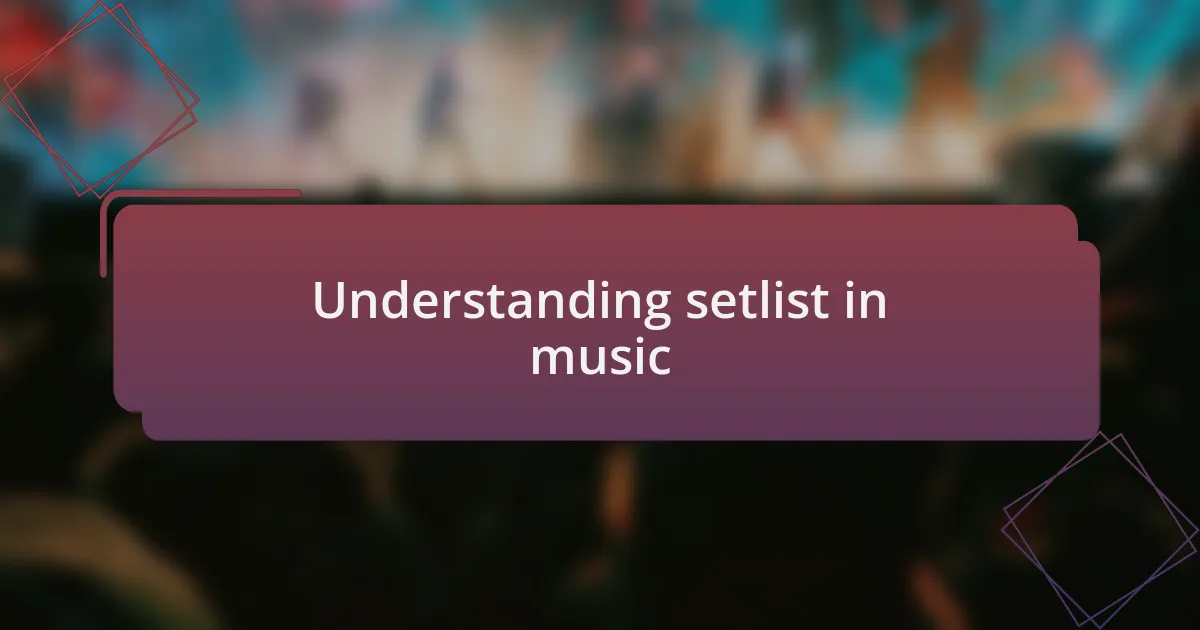
Understanding setlist in music
A setlist is more than just a list of songs; it’s a blueprint for a performance that can shape the entire mood of the event. I remember the first time I was entrusted with crafting a setlist for our band—every song choice felt like a bold statement. How do you balance fan favorites with the risk of introducing new material?
When I consider the flow of a setlist, I often think about the emotional journey we’re taking the audience on. The highs and lows of a setlist can be so powerful—one moment, a thunderous anthem can have the crowd roaring, and then you transition into a haunting ballad that leaves a palpable hush in the room. Isn’t it fascinating how the order in which we present songs can evoke such varied reactions from listeners?
This intricacy deepens when considering the specific context of a show, like whether it’s a small venue or a massive festival stage. I recall a particular night where we threw in a surprise cover song that wasn’t on our typical list. The audience’s response was exhilarating! It made me realize that a setlist is a living document, always evolving based on the vibe of the moment and the energy from the crowd, don’t you think?
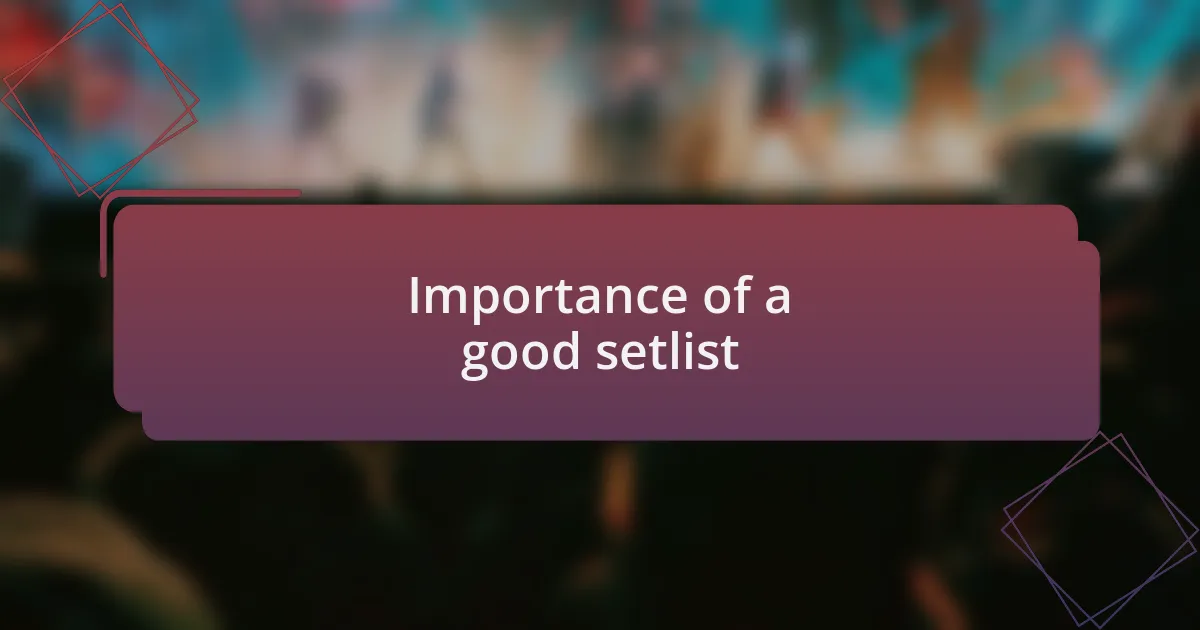
Importance of a good setlist
A well-crafted setlist is crucial because it sets the tone for the entire performance. I remember a gig where I struggled with song placement, and it felt like we lost the audience halfway through. That experience taught me that the right sequence fosters a connection, allowing the energy to build and allowing those emotional peaks and valleys to speak to the crowd in a way that keeps them engaged.
Moreover, a thoughtfully arranged setlist can highlight the band’s versatility and creativity. During a recent show, we decided to alternate heavier tracks with melodic ones, which created a dynamic ebb and flow. I noticed the audience responding differently to each section, as the heavy songs got fists in the air, while upbeat tracks had everyone singing along. Isn’t it amazing how song choice can transform the atmosphere and engage fans on multiple levels?
Finally, a good setlist serves as a strategic tool, guiding our artistic direction and giving us a framework within which to perform. I once had the challenge of including a new song while keeping the old favorites. We placed it strategically in the middle, and the reaction was astonishing. It’s clear to me now that balancing the familiar with the fresh can ignite excitement, ensuring that our audience leaves eager for more. How do you see your own choices impacting the concert vibe?
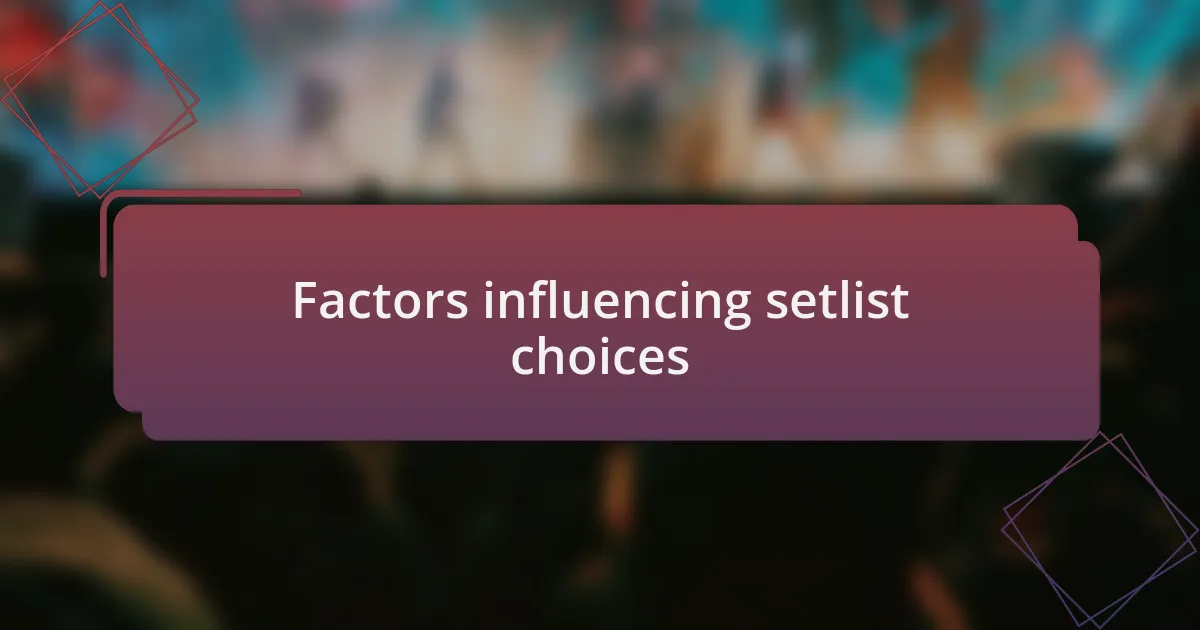
Factors influencing setlist choices
Choosing a setlist isn’t just about picking popular songs; various factors come into play. I often consider the audience. For instance, at a festival, I’ve learned that the crowd can vary significantly from one act to the next. When I noticed a younger audience in front of us, I opted for tracks that resonated with their energy, which made a noticeable difference in their engagement. How do you think age demographics influence what musicians choose to play?
Another major factor is the venue itself. I once played at a smaller club where the intimacy allowed us to experiment with deeper cuts from our albums. The close connection we felt with the audience encouraged us to share stories behind those songs. It’s fascinating how the environment can shape the experience for both the band and the fans, don’t you think?
Lastly, the setlist often reflects the band’s current mood and creative journey. After a challenging songwriting phase, I remember wanting to channel that energy into our live performance. We incorporated raw, emotional tracks that felt cathartic. I find that when we bring that vulnerability to the stage, it resonates with our audience, creating a shared experience that’s incredibly powerful. Have you ever felt that kind of connection during a live show?
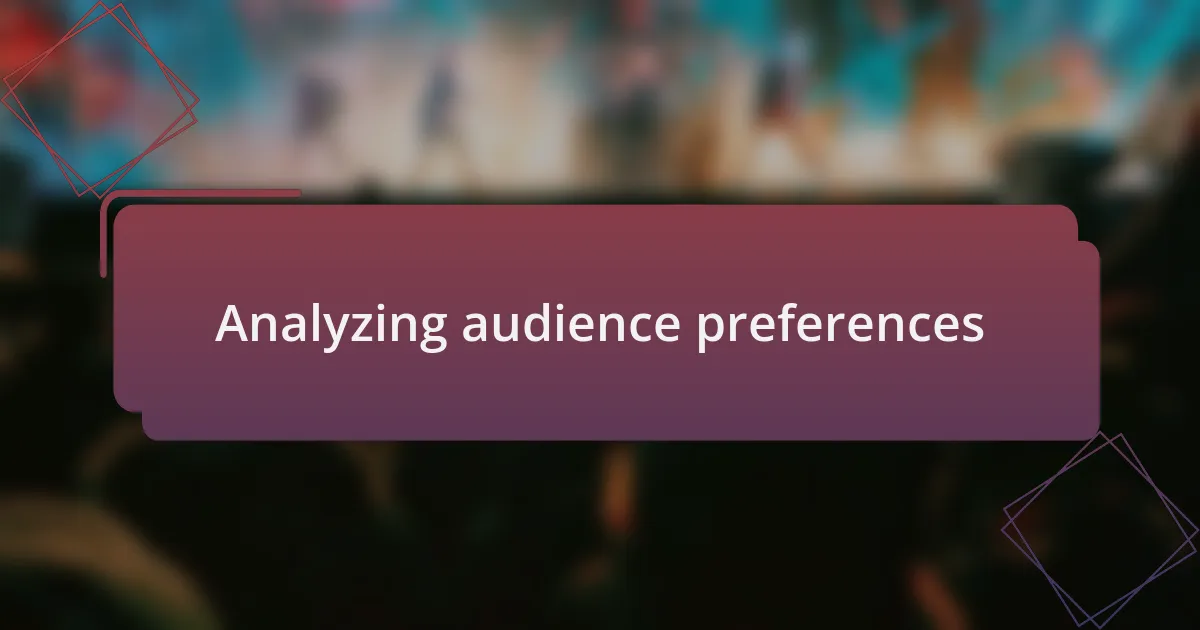
Analyzing audience preferences
Analyzing audience preferences requires an attentive ear to the crowd’s pulse. I recall a show where I could feel the energy shift in the room as we played our heavier tracks. When I saw heads banging and fists pumping, it confirmed that our choice was spot on. Isn’t it amazing how a little interaction can guide us to make better choices for our setlist?
Understanding demographics has opened my eyes to what resonates with different audiences. During a local gig, I noticed that the more seasoned fans responded with nostalgia to our classic songs, while the newer fans were drawn to our latest material. This blend of preferences encouraged me to craft a setlist that satisfied both groups. How often do you consider what the crowd might want to hear?
Engagement goes beyond just song selection; it’s about crafting an experience. At one of our larger shows, I invited the audience to sing along during a well-loved bridge, and the connection created was electric. It reminded me that analyzing preferences isn’t just data; it’s about building a moment we all share. Have you ever had a moment like that at a concert?
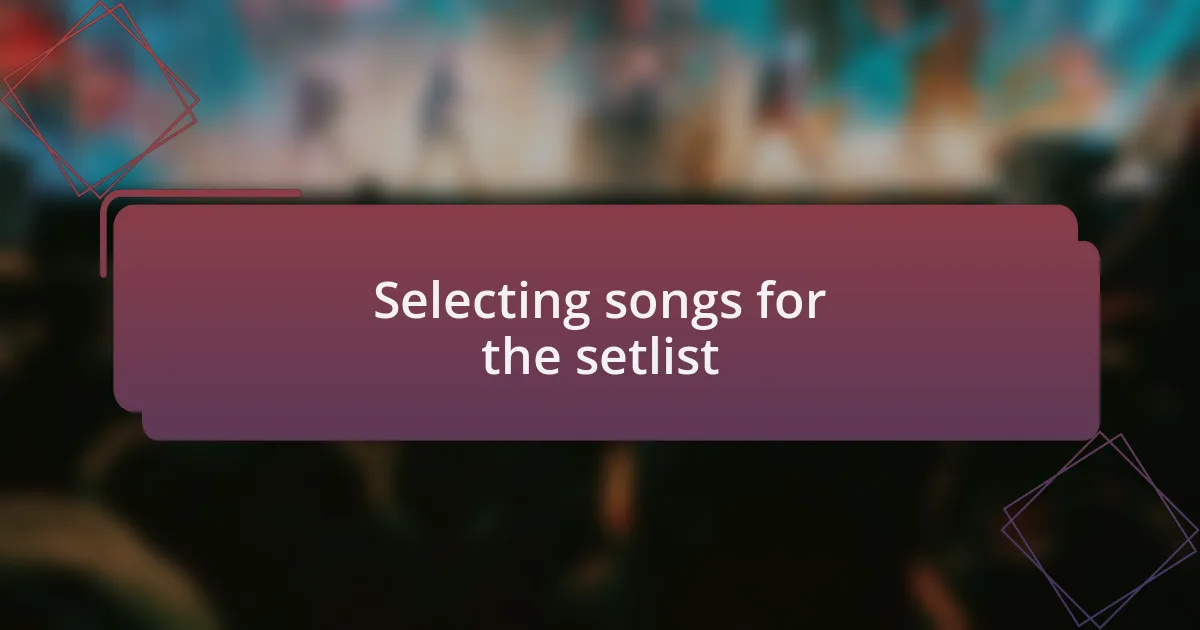
Selecting songs for the setlist
Selecting songs for the setlist is an art form that requires a keen sense of balance. I remember a time when we were preparing for a festival gig, and I had to choose tracks that not only represented our identity but also connected with a diverse crowd. This meant mixing our heaviest songs with some lighter, more melodic tracks to keep the energy flowing—how do you find that balance in your own setlist planning?
One strategy I’ve found effective is the flow of the setlist. Early in my experience, I learned that starting with an explosive track sets the tone. For instance, during a particularly memorable show, we opened with an adrenaline-pumping song that immediately got the audience engaged. That initial rush of connection was a game changer—it’s incredible how the right opener can lift the whole performance. What song do you think could create that same spark for your audience?
Finally, considering the dynamics of the venue plays a crucial role in song selection. I once performed in an intimate club where each note resonated deeply with the audience. In that setting, I chose to bring out some of our more emotive tracks, allowing the crowd to experience the raw power of our music. It taught me how important it is to adapt your setlist not just to audience preferences, but to the environment as well. Have you ever thought about how the venue influences your choices?
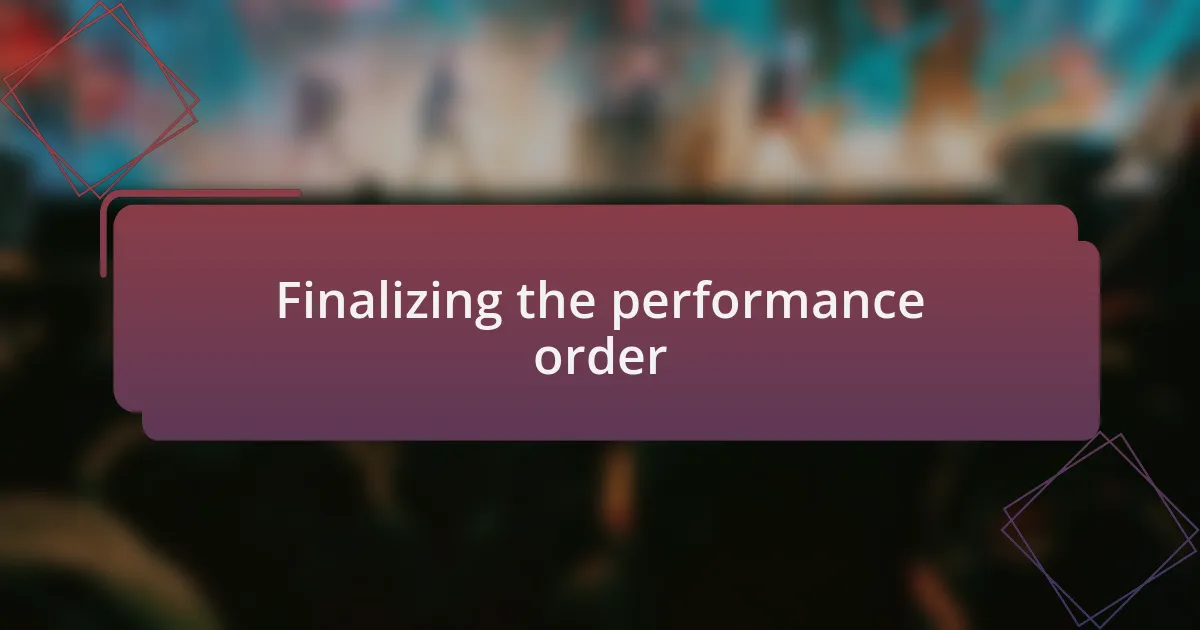
Finalizing the performance order
When it comes to finalizing the performance order, I often reflect on the overall journey I want to take the audience through. There was a time when we positioned our heaviest song right after a more melodic one, creating a wall of sound that struck like lightning. That feedback from the crowd was electric—a reminder that every transition matters. How do you envision crafting emotional peaks and valleys in your own performance?
I’ve learned that balancing high-energy tracks with moments of calm can truly enhance the performance experience. For example, during one show, we followed a bombastic anthem with a slow, somber ballad. The audience took a breath, and you could feel the emotional shift in the room. It’s these contrasts that keep the crowd engaged and eager for what comes next—how do you think your audience anticipates those shifts?
A crucial part of this finalization process is feedback from my bandmates. I remember a rehearsal when one of us suggested swapping two songs based on their feel. That small change made a big difference, leading to a seamless flow that felt natural. It’s vital to have open discussions—do your band members share your vision for the setlist’s arc? Collaborating can lead to insights you’d never consider on your own.